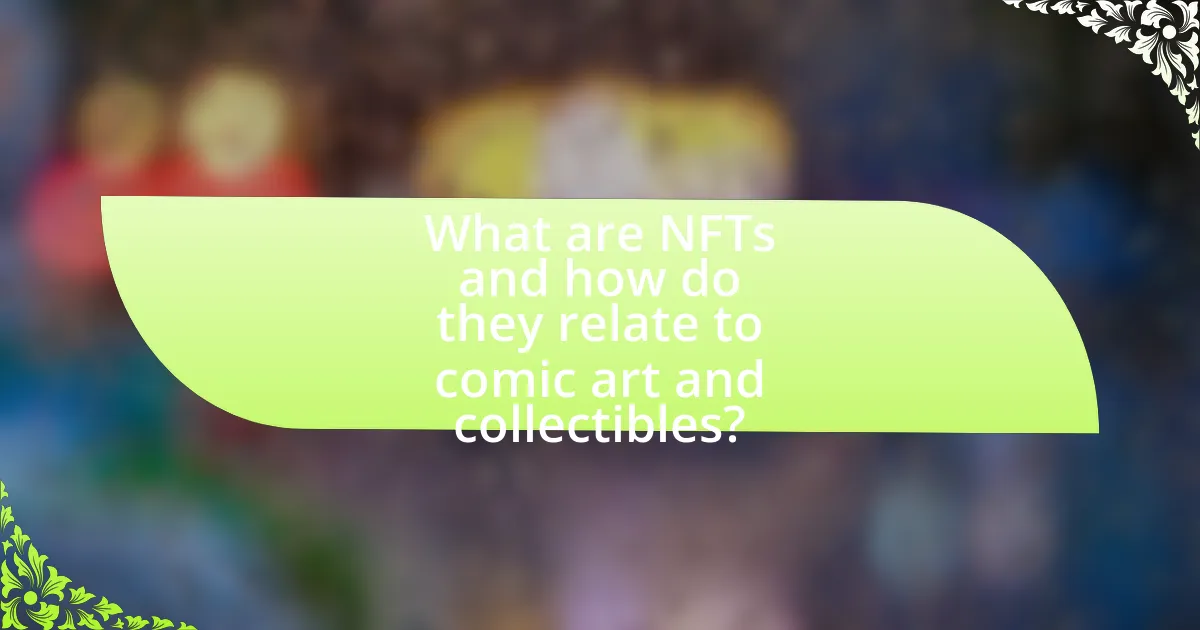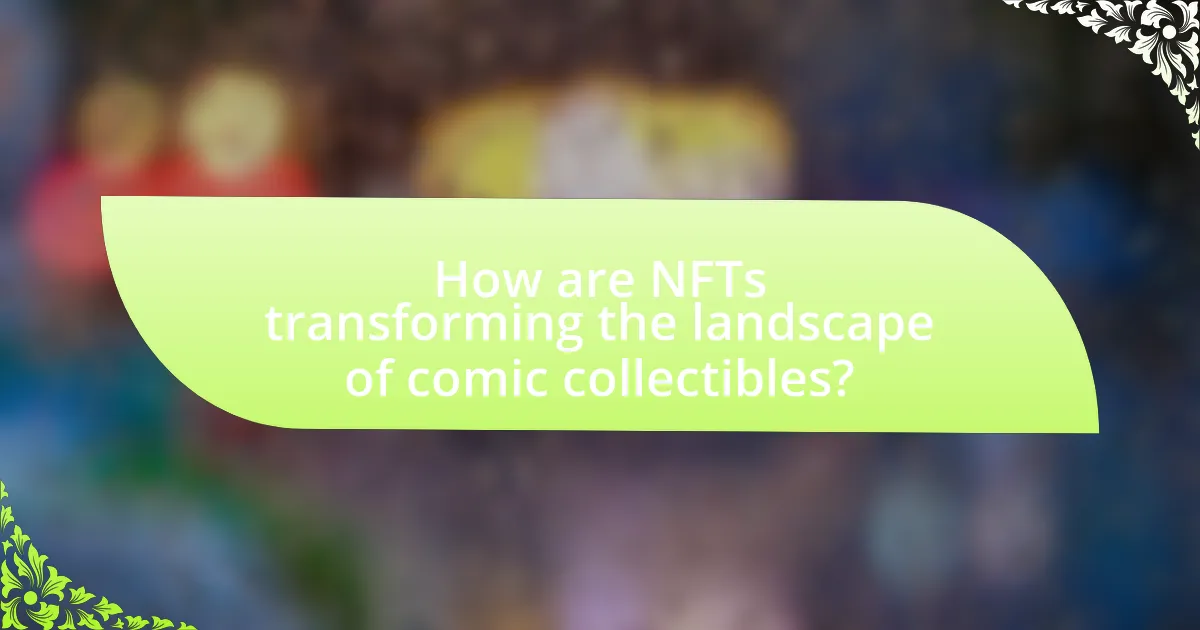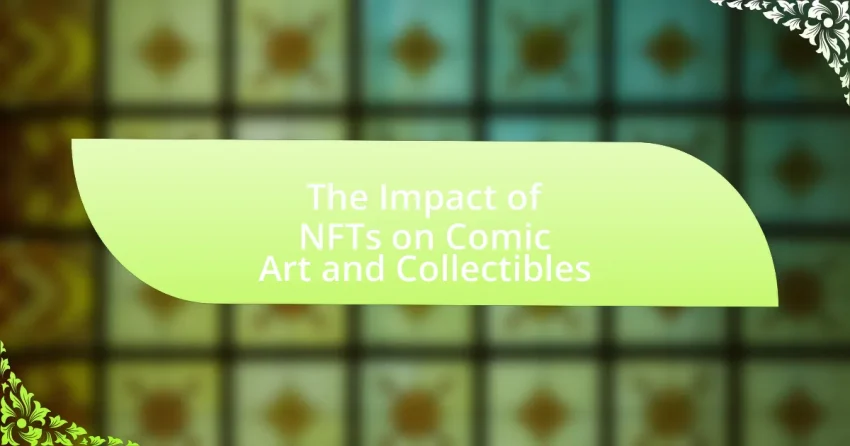The article examines the impact of Non-Fungible Tokens (NFTs) on comic art and collectibles, highlighting how NFTs serve as unique digital assets verified through blockchain technology. It discusses the functionality of NFTs in the digital art space, their creation and sale processes, and the significance they hold for comic artists in terms of new revenue streams and ownership verification. Additionally, the article addresses challenges such as copyright issues, environmental concerns, and market volatility, while exploring future trends and best practices for artists and collectors in navigating the evolving NFT landscape. Overall, it provides a comprehensive overview of how NFTs are transforming the comic art industry and the opportunities and risks they present.

What are NFTs and how do they relate to comic art and collectibles?
NFTs, or Non-Fungible Tokens, are unique digital assets verified using blockchain technology, which ensures their authenticity and ownership. In the context of comic art and collectibles, NFTs allow artists and creators to tokenize their work, enabling them to sell digital versions of comic art as limited editions or one-of-a-kind pieces. This transformation has created new revenue streams for artists, as NFTs can include royalties on secondary sales, ensuring that creators benefit from future transactions. The market for NFT comic art has grown significantly, with sales reaching millions of dollars, demonstrating the increasing value and interest in digital collectibles within the comic community.
How do NFTs function in the digital art space?
NFTs function in the digital art space by providing a unique, verifiable ownership record for digital artworks on blockchain technology. This ownership is established through smart contracts, which ensure that each NFT is distinct and cannot be replicated, thus preserving the scarcity and value of the digital art. According to a report by NonFungible.com, the NFT market reached a valuation of over $10 billion in 2021, demonstrating significant financial interest and investment in digital art assets. This mechanism allows artists to sell their work directly to collectors, often retaining royalties on future sales, which enhances their revenue potential compared to traditional art markets.
What technology underpins NFTs?
Blockchain technology underpins NFTs. This decentralized digital ledger enables the creation, ownership, and transfer of non-fungible tokens, ensuring authenticity and provenance. Each NFT is uniquely identified on the blockchain, typically using standards like ERC-721 or ERC-1155 on the Ethereum network, which facilitates the verification of ownership and transaction history. This technology provides a secure and transparent framework for digital assets, making it possible to buy, sell, and trade NFTs in a verifiable manner.
How are NFTs created and sold?
NFTs are created through a process called minting, which involves uploading digital content to a blockchain, typically Ethereum, and generating a unique token that represents ownership of that content. This process includes selecting the digital asset, such as artwork or collectibles, and using a smart contract to define the NFT’s properties and ownership details. NFTs are sold on various online marketplaces, such as OpenSea or Rarible, where creators can list their tokens for sale, set prices, and engage in auctions. The sale process often involves cryptocurrency transactions, allowing buyers to purchase NFTs directly using digital currencies like Ether.
What is the significance of NFTs for comic artists?
NFTs are significant for comic artists as they provide a new revenue stream and enhance ownership verification. By minting their artwork as NFTs, comic artists can sell unique digital editions directly to collectors, bypassing traditional publishing constraints. This direct-to-consumer model allows artists to retain a larger share of profits, as they can set their own prices and receive royalties on secondary sales through smart contracts. Additionally, NFTs enable artists to establish provenance and authenticity, which is crucial in the art market, as each NFT is recorded on a blockchain, ensuring that ownership history is transparent and immutable. This shift empowers comic artists to engage with their audience in innovative ways, fostering community and increasing the value of their work in the digital landscape.
How do NFTs provide new revenue streams for artists?
NFTs provide new revenue streams for artists by enabling them to sell digital artwork directly to consumers while retaining ownership rights. This direct-to-consumer model eliminates intermediaries, allowing artists to receive a larger share of the sale price. Additionally, NFTs can include smart contracts that enable artists to earn royalties on secondary sales, ensuring they benefit from the increasing value of their work over time. For instance, artists like Beeple have sold NFTs for millions, demonstrating the potential for significant income through this innovative medium.
What opportunities do NFTs create for artistic expression?
NFTs create significant opportunities for artistic expression by enabling artists to tokenize their work, ensuring ownership and provenance in the digital space. This tokenization allows artists to reach a global audience without traditional gatekeepers, such as galleries or publishers, thus democratizing access to art. Furthermore, NFTs facilitate new revenue streams through royalties on secondary sales, allowing artists to benefit financially from the ongoing appreciation of their work. The unique characteristics of NFTs, such as interactivity and programmability, also enable artists to create dynamic and evolving pieces that can engage audiences in innovative ways.
What challenges do NFTs present to the comic art industry?
NFTs present significant challenges to the comic art industry, primarily through issues of copyright infringement and market saturation. The decentralized nature of NFTs allows for easy reproduction and distribution of digital art, which can lead to unauthorized sales and the dilution of original creators’ rights. Additionally, the rapid proliferation of NFTs can overwhelm collectors and investors, making it difficult for individual comic artists to stand out in a crowded marketplace. According to a report by NonFungible.com, the NFT market saw a surge in transactions, but this also resulted in a volatile environment where the value of digital assets can fluctuate dramatically, further complicating the economic landscape for comic artists.
How do copyright issues affect NFT comic art?
Copyright issues significantly impact NFT comic art by determining the ownership and usage rights of the digital artwork. When an artist creates a comic and mints it as an NFT, they must ensure they hold the copyright or have permission to use any copyrighted material included in the artwork. Failure to do so can lead to legal disputes, as copyright holders can claim infringement, potentially resulting in the removal of the NFT from marketplaces or financial penalties for the creator. For instance, a 2021 case involving the artist Mike Winkelmann, known as Beeple, highlighted the importance of copyright when his work was scrutinized for originality and ownership rights, emphasizing that NFT creators must navigate these legal complexities to protect their art and investments.
What are the environmental concerns associated with NFTs?
The environmental concerns associated with NFTs primarily stem from their reliance on blockchain technology, particularly proof-of-work systems, which consume significant amounts of energy. For instance, the Ethereum blockchain, which has been widely used for NFTs, was reported to consume approximately 45 terawatt-hours of electricity annually, comparable to the energy usage of some small countries. This high energy consumption contributes to increased carbon emissions, especially when the energy sources are fossil fuels. Additionally, the production and transaction of NFTs can lead to electronic waste due to the hardware required for mining and maintaining blockchain networks.

How are NFTs transforming the landscape of comic collectibles?
NFTs are transforming the landscape of comic collectibles by providing a digital ownership model that enhances provenance and scarcity. This technology allows comic creators to tokenize their work, ensuring that each piece has a verifiable history and ownership record on the blockchain. For instance, platforms like OpenSea and Rarible have facilitated the sale of NFT comics, enabling artists to reach global audiences and retain a larger share of profits compared to traditional publishing. Additionally, the unique attributes of NFTs, such as the ability to include exclusive content or unlockable features, create new engagement opportunities for collectors. As a result, the market for comic collectibles is evolving, with sales of NFT comics reaching millions, exemplified by the sale of a single NFT comic for over $1.2 million in 2021, highlighting the significant financial impact of this transformation.
What advantages do NFTs offer to collectors of comic art?
NFTs offer collectors of comic art unique ownership verification and provenance tracking. This digital ownership is secured on the blockchain, ensuring that each piece is authenticated and cannot be duplicated, which enhances its value. Additionally, NFTs can include smart contracts that allow artists to receive royalties on future sales, creating a sustainable income model. The ability to trade and sell NFTs on various platforms also provides collectors with liquidity and access to a global market, increasing the potential for appreciation in value.
How do NFTs enhance the value of comic collectibles?
NFTs enhance the value of comic collectibles by providing verifiable ownership and authenticity through blockchain technology. This digital proof of ownership ensures that each NFT is unique and cannot be duplicated, which increases the rarity and desirability of the comic collectible. For instance, the sale of an NFT linked to a popular comic issue can fetch significantly higher prices than physical copies due to the perceived value of owning a one-of-a-kind digital asset. Additionally, NFTs can include exclusive content or perks, such as access to special events or future releases, further elevating their value in the eyes of collectors.
What unique features do NFTs provide compared to traditional collectibles?
NFTs provide unique features such as verifiable ownership, scarcity, and programmability compared to traditional collectibles. Unlike physical items, NFTs are stored on a blockchain, ensuring that ownership is transparent and easily verifiable. This digital provenance allows collectors to confirm authenticity and ownership history, which is often difficult with traditional collectibles. Additionally, NFTs can be programmed with smart contracts, enabling features like royalties for creators on secondary sales, a capability that traditional collectibles lack. These attributes enhance the value proposition for collectors and artists alike, as evidenced by the growing market for digital art and collectibles, which reached over $2 billion in sales in 2021.
What are the potential downsides for collectors in the NFT space?
Collectors in the NFT space face several potential downsides, including market volatility, lack of regulation, and the risk of digital asset loss. Market volatility can lead to significant price fluctuations, making investments unpredictable; for instance, the value of NFTs can drop dramatically within a short period, as seen in the 2022 NFT market downturn where sales plummeted by over 90%. The lack of regulation means that collectors may encounter fraudulent projects or scams, with no legal recourse available. Additionally, digital asset loss can occur due to hacking or technical failures, as evidenced by high-profile thefts where millions in NFTs were stolen from collectors’ wallets. These factors contribute to a challenging environment for NFT collectors.
How can market volatility impact NFT comic collectibles?
Market volatility can significantly impact NFT comic collectibles by influencing their prices and demand. When market conditions fluctuate, the perceived value of NFTs can rise or fall sharply, leading to increased speculation among collectors. For instance, during periods of high volatility, collectors may hesitate to invest, fearing losses, which can decrease demand and subsequently lower prices. Conversely, in a bullish market, heightened interest can drive prices up, as seen in 2021 when NFT sales surged, with some comic collectibles selling for millions. This correlation between market volatility and NFT prices highlights the sensitivity of digital collectibles to broader economic trends.
What risks do collectors face regarding authenticity and fraud?
Collectors face significant risks regarding authenticity and fraud, primarily due to the prevalence of counterfeit items and misrepresented artworks. The rise of digital platforms has made it easier for fraudulent sellers to create and distribute fake collectibles, undermining the value of genuine pieces. According to a report by the International Foundation for Art Research, approximately 20% of artworks in the secondary market are believed to be forged or misattributed. This statistic highlights the critical need for collectors to verify the provenance and authenticity of items before purchase. Additionally, the lack of standardized authentication processes in the comic art and collectibles market further exacerbates these risks, making it essential for collectors to seek expert opinions and utilize reliable certification services to mitigate potential losses.

What future trends can we expect in the intersection of NFTs and comic art?
Future trends in the intersection of NFTs and comic art include increased integration of augmented reality (AR) features, allowing collectors to experience comic art in immersive environments. This trend is supported by the growing popularity of AR technology, which enhances user engagement and interaction with digital collectibles. Additionally, we can expect a rise in collaborations between established comic publishers and NFT platforms, as seen with Marvel and DC Comics exploring NFT releases, which will likely lead to exclusive content and limited editions. Furthermore, the market for fractional ownership of high-value comic NFTs is anticipated to expand, enabling more collectors to invest in premium assets. This trend is backed by the success of platforms like Rally, which have demonstrated the viability of fractional ownership in collectibles.
How might the adoption of NFTs evolve in the comic industry?
The adoption of NFTs in the comic industry is likely to evolve through increased integration of digital ownership and unique collectibles. As comic creators and publishers recognize the potential for NFTs to provide verifiable ownership and provenance, they may begin to release exclusive digital editions and limited-run artworks as NFTs. This shift is supported by the growing trend of digital art sales, which reached $2.6 billion in 2021, indicating a robust market for digital collectibles. Furthermore, platforms like OpenSea and Rarible are facilitating the entry of comic artists into the NFT space, allowing them to monetize their work directly and engage with fans in new ways. This evolution may also lead to collaborations between traditional comic publishers and NFT marketplaces, enhancing the visibility and accessibility of comic NFTs.
What role will community engagement play in NFT comic projects?
Community engagement will play a crucial role in NFT comic projects by fostering a sense of ownership and collaboration among fans. Engaged communities can drive demand for NFTs, as they actively participate in discussions, share content, and promote projects, leading to increased visibility and sales. For instance, projects like “World of Women” have demonstrated that strong community involvement can result in higher market value and sustained interest, as evidenced by their active Discord channels and social media presence, which facilitate direct interaction between creators and collectors. This engagement not only enhances the project’s reach but also creates a loyal customer base that is essential for the long-term success of NFT comic initiatives.
How could technological advancements shape the future of NFTs in comics?
Technological advancements could significantly enhance the future of NFTs in comics by enabling more interactive and immersive experiences for collectors and readers. Innovations such as augmented reality (AR) and virtual reality (VR) can allow users to engage with comic content in dynamic ways, such as viewing 3D models of characters or environments. Additionally, blockchain technology improvements can facilitate more secure and transparent transactions, ensuring authenticity and provenance of digital comic assets. For instance, Ethereum’s transition to a proof-of-stake model has already reduced energy consumption, making NFT transactions more sustainable. These advancements not only increase the value proposition of NFTs in comics but also expand the potential for storytelling and community engagement within the comic book ecosystem.
What best practices should artists and collectors follow in the NFT space?
Artists and collectors in the NFT space should prioritize transparency, authenticity, and community engagement. Transparency involves clearly communicating the provenance and details of each NFT, ensuring that buyers understand the value and history of the digital asset. Authenticity is crucial; artists must verify their identity and ownership of the artwork to prevent fraud, while collectors should only purchase from reputable sources. Community engagement fosters relationships and trust, as active participation in discussions and events can enhance visibility and support for both artists and collectors. According to a report by NonFungible.com, the NFT market has seen significant growth, with sales reaching over $10 billion in 2021, highlighting the importance of these best practices in navigating a rapidly evolving landscape.
How can artists effectively market their NFT comic art?
Artists can effectively market their NFT comic art by leveraging social media platforms, engaging with communities, and utilizing NFT marketplaces. Social media platforms like Twitter and Instagram allow artists to showcase their work, build a following, and connect with potential buyers. Engaging with communities on platforms such as Discord or Reddit helps artists to create a loyal fan base and gain visibility. Additionally, listing their NFT comic art on established NFT marketplaces like OpenSea or Rarible increases exposure to a broader audience, as these platforms attract collectors specifically looking for digital art. According to a report by NonFungible.com, the NFT market saw a significant increase in sales, reaching over $10 billion in 2021, indicating a growing interest in digital collectibles.
What strategies should collectors use to navigate the NFT market safely?
Collectors should employ due diligence, diversify their investments, and utilize secure wallets to navigate the NFT market safely. Conducting thorough research on the NFT projects, including the creators’ backgrounds and the community’s engagement, helps mitigate risks associated with scams and low-quality assets. Diversification across various NFTs reduces the impact of any single asset’s poor performance, while using secure wallets, such as hardware wallets, protects against hacks and unauthorized access. According to a report by NonFungible.com, the NFT market saw a significant increase in scams, with over $7 million lost to fraudulent projects in 2021, highlighting the importance of these strategies for safe navigation.
